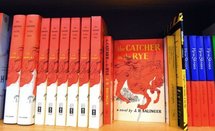Reclusive writer J.D. Salinger dead at 91
Jo Biddle
WASHINGTON, Jo Biddle - Reclusive author J.D. Salinger, who has died aged 91, was a giant of American literature whose seminal novel "The Catcher in the Rye" lent a voice to the angst and despair of generations of rebellious adolescents.
One of the most admired and influential US writers following the success of his 1951 novel and its laconic anti-hero Holden Caulfield, Salinger published nothing after 1965 and had not been interviewed since 1980.

Mystery surrounded much of the last five decades of his life. After being overwhelmed by his new fame, Salinger withdrew from public life, retreating to his house perched on a tree-blanketed hill in the small town of Cornish, New Hampshire.
Memoirs written by his daughter and a former lover affirmed that Salinger still wrote, but there has been no sign of any new book despite the entreaties of his legions of fans.
Indeed in a rare interview with the Boston Sunday Globe in 1980, Salinger said: "I love to write, and I assure you I write regularly. But I write for myself and I want to be left absolutely alone to do it."
News in 1997 that his last published work "Hapworth 16: 1924," which appeared in the New Yorker magazine, was about to be reissued in hard print sparked excitement in the literary world. But the publication date was frequently postponed, with no reason given.
Jerome David Salinger was born on New Year's Day 1919 in Manhattan, New York, the son of an Irish mother and Jewish father with Polish roots.
As a teenager he began writing stories. In 1940, his debut story "The Young Ones" about several aimless youths was published in "Story" magazine.
Then came America's entry into the war, and the young Salinger was drafted in 1942. He took part in the D-Day stormings of the Normandy beaches, and his wartime experiences are said to have marked him for life.
He married a German woman after the war, but the marriage fell apart after just a few months, and Salinger renewed his writings with a passion.
In 1948 he published the short story "A Perfect Day for Bananafish" in the New Yorker, bringing him acclaim and introducing the Glass family and its seven rambunctious children Seymour Buddy, Boo Boo, Walt, Waker, Zooey, and Franny, who were to populate several of his short stories.
But it was "The Catcher in the Rye," published three years later, that was to seal his reputation. The book was an instant success, and even today remains recommended reading at many high schools, selling around 250,000 copies a year.
Sixteen-year-old Holden Caulfield's adventures and musings as he makes his way home after being kicked out of school touched a raw nerve and have fascinated generations of disaffected youngsters.
Yet the novel was also sharply criticized for its liberal use of swear words and open references to sex, and was banned in some countries.
Always a private person, Salinger found his new fame oppressive, and in 1953 he moved to sleepy Cornish, in the hope of staying out of the limelight.
Other collections of short stories or novellas followed, such as "Franny and Zooey," until his last published work "Hapworth 16: 1924" appeared in the New Yorker magazine in 1965.
"There is a marvelous peace in not publishing. It's peaceful," Salinger said in 1974, when he broke more than 20 years of silence in a phone interview with the New York Times.
"Publishing is a terrible invasion of my privacy. I like to write. I love to write. But I write just for myself and my own pleasure."
Roger Lathbury, whose Orchises publishing house acquired, then lost, the rights in the 1990s to publish in hardback Salinger's "Hapworth 16, 1924," said the literary world is salivating at the prospect of new, unpublished works.
"Nobody knows how much there is of it, nobody knows what it's like, nobody knows," he said.
In 1955 Salinger married a young student, Claire Douglas, and they had two children, Margaret and Matt. In Margaret's memoirs "The Dream Catcher" she reflects on an often painful childhood, describing her father as an autocratic man who kept her mother as a "virtual prisoner."
They divorced in 1967, and in 1972 Salinger began a year-long relationship with 18-year-old Joyce Maynard, with whom he had been exchanging letters.
In a sign of the lingering interest in Salinger, some letters he wrote to Maynard sold for more than 150,000 dollars at auction in 1999.
Salinger remained to the end of his life in his Cornish home, and had been married to Collen O'Neill since the 1980s. He fiercely guarded his privacy to the end refusing all offers to sell the screen rights to "Catcher."
One of his final moves came in July when a US judge suspended publication of an unauthorized sequel to "Catcher" by Swedish author Fredrik Colting.
"There's no more to Holden Caulfield. Read the book again. It's all there. Holden Caulfield is only a frozen moment in time," Salinger told the Boston Globe.
---------------------------------------------------------------------------